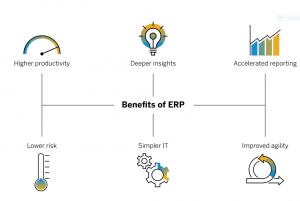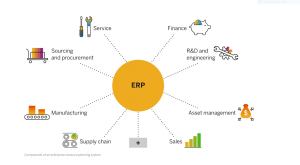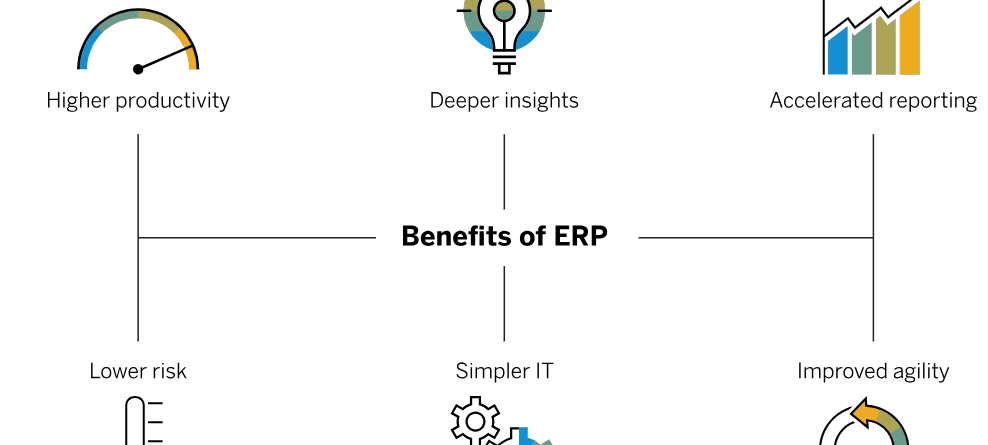What is ERP?
Enterprise resource planning (ERP) is a software system that helps small companies run their entire business, supporting automation and processes in finance, human resources, manufacturing, supply chain, services, procurement, and more.
ERP definition in detail
ERP stands for enterprise resource planning, but what does ERP mean? The simplest way to define ERP is to think about all the core business processes needed to run a company: finance, HR, manufacturing, supply chain, services, procurement, and others. At its most basic level, ERP helps to efficiently manage all these processes in an integrated system. It is often referred to as the system of record of the organization.
Yet today’s ERP systems are anything but basic and have little resemblance to the ERP of decades ago. They are now delivered via the cloud and use the latest technologies – such as artificial intelligence (AI) and machine learning – to provide intelligent automation, greater efficiency, and instant insight across the business. Modern cloud ERP software also connects internal operations with business partners and networks around the world, giving companies the collaboration, agility, and speed they need to be competitive today.
Why is ERP important?
Sometimes described as “the central nervous system of an enterprise,” an ERP software system provides the automation, integration, and intelligence that is essential to efficiently run all day-to-day business operations. Most or all of an organization’s data should reside in the ERP system to provide a single source of truth across the business.
Finance requires an ERP to quickly close the books. Sales needs ERP to manage all customer orders. Logistics relies on well-running ERP software to deliver the right products and services to customers on time. Accounts payable needs ERP to pay suppliers correctly and on time. Management needs instant visibility into the company’s performance to make timely decisions. And banks and shareholders require accurate financial records, so they count on reliable data and analysis made possible by the ERP system.
The importance of ERP software to businesses is illustrated by the growing adoption rate. According to G2, “The global ERP software market is projected to reach US$78.40 billion by 2026, growing at a CAGR of 10.2% from 2019 to 2026.”
Six key benefits of ERP
A good ERP system offers many advantages — which can vary depending on how the system is deployed. The benefits of cloud ERP, for example, are different than on premise. That said, there are six major benefits that apply to all modern ERP solutions:.

- Higher productivity: Streamline and automate your core business processes to help everyone in your organization do more with fewer resources.
- Deeper insights: Eliminate information silos, gain a single source of truth, and get fast answers to mission-critical business questions.
- Accelerated reporting: Fast-track business and financial reporting and easily share results. Act on insights and improve performance in real time.
- Lower risk: Maximize business visibility and control, ensure compliance with regulatory requirements, and predict and prevent risk.
- Simpler IT: By using integrated ERP applications that share a database, you can simplify IT and give everyone an easier way to work.
- Improved agility: With efficient operations and ready access to real-time data, you can quickly identify and react to new opportunities.
How do ERP systems work?
An ERP system – also called an ERP suite – is made up of integrated modules or business applications that talk to each other and share common a database.
Each ERP module typically focuses on one business area, but they work together using the same data to meet the company’s needs. Finance, accounting, human resources, sales, procurement, logistics, and supply chain are popular starting points. Companies can pick and choose the module they want and can add on and scale as needed.
ERP systems also support industry-specific requirements, either as part of the system’s core functionality or through application extensions that seamlessly integrate with the suite.
ERP software can be bought using a cloud subscription model (software-as-a-service) or a licensing model (on premise).
Common ERP modules

The most widely used ERP modules include:
- Finance: The finance and accounting module is the backbone of most ERP systems. In addition to managing the general ledger and automating key financial tasks, it helps businesses track accounts payable (AP) and receivable (AR), close the books efficiently, generate financial reports, comply with revenue recognition standards, mitigate financial risk, and more.
- Human resources management: Most ERP systems include an HR module that provides core capabilities such as time and attendance and payroll. Add-ons, or even entire human capital management (HCM) suites, can connect to the ERP and deliver more robust HR functionality – everything from workforce analytics to employee experience management.
- Sourcing and procurement: The sourcing and procurement module helps businesses procure the materials and services they need to manufacture their goods – or the items they want to resell. The module centralizes and automates purchasing, including requests for quotes, contract creation, and approvals. It can minimize underbuying and overbuying, improve supplier negotiations with AI-powered analytics, and even seamlessly connect with buyer networks.
- Sales: The sales module keeps track of communications with prospects and customers – and helps reps use data-driven insights to increase sales and target leads with the right promotions and upsell opportunities. It includes functionality for the order-to-cash process, including order management, contracts, billing, sales performance management, and sales force support.
- Manufacturing: The manufacturing module is a key planning and execution component of ERP software. It helps companies simplify complex manufacturing processes and ensure production is in line with demand. This module typically includes functionality for material requirements planning (MRP), production scheduling, manufacturing execution, quality management, and more.
- Logistics and supply chain management: Another key component of ERP systems, the supply chain module tracks the movement of goods and supplies throughout an organization’s supply chain. The module provides tools for real-time inventory management, warehousing operations, transportation, and logistics – and can help increase supply chain visibility and resilience.
- Service: In an ERP, the service module helps companies deliver the reliable, personalized service customers have come to expect. The module can include tools for in-house repairs, spare parts, field service management, and service-based revenue streams. It also provides analytics to help service reps and technicians rapidly solve customer issues and improve loyalty.
- R&D and engineering: Feature-rich ERP systems include an R&D and engineering module. This module provides tools for product design and development, product lifecycle management (PLM), product compliance, and more – so companies can quickly and cost-effectively create new innovations.
- Enterprise asset management: Robust ERP systems can include an EAM module – which helps asset-intensive businesses minimize downtime and keep their machines and equipment running at peak efficiency. This module includes functionality for predictive maintenance, scheduling, asset operations and planning, environment, health and safety (EHS), and more.
Types of ERP deployment
Modern ERP systems can be deployed in a number of ways: in a public or private cloud, on premise, or in various hybrid scenarios that combine environments. Here are some of the high-level benefits of each to help you identify the ERP deployment option that makes the most sense for your business.
With cloud ERP, the software is hosted in the cloud and delivered over the Internet as a service that you subscribe to. The software provider generally takes care of regular maintenance, updates, and security on your behalf. Today, cloud ERP is the most popular deployment method for many reasons – including lower upfront costs, greater scalability and agility, easier integration, and much more.
This is the traditional model for deploying software where you control everything. The ERP software is typically installed in your data center at the locations of your choice. The installation and maintenance of the hardware and software is your staff’s responsibility.
Many companies are modernizing and upgrading their on-premise ERP systems to cloud deployments. This requires careful planning of your ERP upgrade as well as a thoughtful process of evaluating ERP software and deployment options.
For companies that want a mixture of both to meet their business requirements, there is the hybrid cloud ERP model. This is where some of your ERP applications and data will be in the cloud and some on premise. Sometimes this is referred to as two-tier ERP.
ERP integration
Today’s ERP systems provide an enormous range of business functionality, but they still need to connect to and synchronize with other applications and data sources – such as CRM and HCM software, e-commerce platforms, industry-specific solutions, and even other ERPs. With ERP integration, companies can gain a unified view of information from different systems, increase business process efficiency, improve customer experiences, and facilitate collaboration across teams and business partners.
Modern ERP systems are open and flexible – and can easily integrate with a wide range of software products using connectors or customized adaptors, such as application programming interfaces (APIs). Other methods for ERP integration include ESB (enterprise service bus) and iPaaS (integration platform-as-a-service). iPaaS, which offers a cloud-based approach, is a very popular option for modern businesses. iPaaS platforms can rapidly sync on-premise or cloud-based ERP with SaaS applications from the same vendor or third-parties. They typically require little-to-no coding, they’re flexible and relatively inexpensive, and they offer a whole host of other uses – such as automatic API generation, machine learning data integration, Internet of Things (IoT) network integration, prebuilt content, and more.
The total cost of ERP
The cost of ERP depends on the software vendor, the modules selected, and the deployment method. Generally speaking, cloud-based ERP has lower costs than on-premise ERP because there is no hardware that needs to be purchased – and no expensive in-house IT experts that need to be hired. The vendor handles the maintenance and charges the customer an annual or monthly subscription fee, usually based on the number of users.
When calculating the return on investment (ROI) and total cost of ownership (TCO) of a new ERP implementation, the initial and ongoing workforce costs are just as important as the software selection and deployment costs. With cloud and hybrid options, new factors must be evaluated. For example, software maintenance, facility, computer capacity, downtime, recovery, security, privacy, and IT staff costs are all important considerations. As mentioned, cloud options significantly reduce both capital and operating costs – improving both ROI and TCO.
ERP history: The rapid evolution of ERP
Computerized business applications were born in the accounting and finance world in the 1960’s using mainframe computers. These pioneering applications were faster and more accurate than manual processes – but were expensive, limited in functionality, and still slow. Before long, these applications spawned the development of dedicated, standalone solutions such as sales order processing and manufacturing requirements planning (MRP).
In the mid 1980’s, competition in the manufacturing sector was exploding and new tools were required. New MRP II software integrated accounting and finance, sales, purchasing, inventory, and manufacturing planning and scheduling – providing the manufacturer with an integrated system.
Near the end of the 1990’s, ERP was introduced. ERP transformed the technology sector by serving a broader range of industries and by combining MRP II, human resources, project accounting, and end-user reporting.
In the short span of the 21st century, faster Internet speeds and new development tools have again revolutionized ERP suites. The introduction of browser-based software paved the way for cloud ERP software, a breakthrough that has expanded both the reach and the functionality of ERP solutions.
Today – in the era of digital transformation – modern ERP systems are increasingly taking advantage of new intelligent technologies such as AI, machine learning, robotic process automation (RPA), the IoT, natural language processing (NLP), and in-memory databases. They provide businesses with the ability to run even more efficient processes, leverage up-to-the-minute insights from both transactional and unstructured data, and ultimately remain competitive in a time of unprecedented change.
The future of ERP
Digital transformation is speeding up – and ERP is at the core. As enterprises adopt digital technologies in every part of the business, they are fundamentally changing the way they operate.
According to Gartner, one of the core digital business accelerators is to “banish drags” – in other words, eliminate any negative force that slows the business down, including outdated processes and systems. So, it’s not surprising that companies are already demanding more robust ERP systems.
Following are three major trends that build on the momentum we see today:
- Cloud, cloud, cloud: Preference for cloud ERP will continue to intensify as more and more companies discover the benefits – including “anywhere” access, reduced cost of hardware and technical support, greater security, and integration with other systems, to name just a few. According to Panorama Research in their 2020 ERP Report, “More than half of organizations are selecting cloud software (63%) instead of on-premises software (37%).” As the speed of business continues to accelerate, cloud becomes even more essential.
- Vertical integration: The tug of war between best-of-breed solutions and integrated ERP is officially over. Going forward, we believe that companies will demand the best of both worlds – a fully integrated ERP system with vertical extensions. This allows companies to get the specific functionality they need, without painful integration issues or data locked in information silos. We also see the shift toward ever greater flexibility, as business processes are tailored to individual company needs.
- User personalization: Staff, customers, and suppliers all want content and functionality that matches their specific needs or interests and makes them more productive. The changing demographics of the workforce, particularly in industries such as manufacturing, are also driving interest in low-code, no-code platforms. These platforms allow users to get the experience they want, rather than having to adapt to the software. Users can also expect customized dashboards, AI-driven search, personalized chat, and personalized workflows across devices.
Explore more ERP technology trends – and learn how to systematically evaluate your options, avoid pitfalls, and get started with the right innovations for your business.
10 things to look for in an ERP system
Any modern ERP system will have a long list of capabilities based on the industry they serve and the modules they offer. However, there are 10 fundamental features that all enterprise resource management systems should have:
- A common database: Centralized information and single version of the truth – providing consistent, shared data and a cross-functional view of the company.
- Embedded analytics: Built-in analytics, self-service BI, reporting, and compliance tools that can deliver intelligent insight for any area of the business.
- Data visualization: Visual presentation of key information with dashboards, KPIs, and point-and-click analytics to assist in quick and informed decision-making.
- Automation. Automation of repetitive tasks as well as advanced RPA powered by AI and machine learning.
- Consistent UI/UX: The same look and feel across modules – as well as easy-to-use configuration and personalization tools for processes, users (including customers and suppliers), business units, locations, and product lines, for example.
- Integration: Seamless integration of business processes and workflows – as well as open and easy integration with other software solutions and data sources, including from third parties.
- New technologies: Support for AI and machine learning, digital assistants, the IoT, RPA, security and privacy, and mobile.
- Technology platform: A fast, proven, and stable technology stack for this long-term investment – including a low-code/no-code platform, iPaaS, data management, and more.
- Multinational support: Including for languages, currencies, and local business practices and regulations – as well as technical support for cloud services, training, help desk, and implementation.
- Choice of deployment: Cloud, on-premise, or hybrid.
ERP at any size: What are my options?
ERP software for small businesses can help you move beyond spreadsheets and efficiently manage every aspect of your growing company – from sales and customer relationships to financials and operations. Small business ERP tools are typically in the cloud, quick to install, and designed to grow with you.
Today, ERP software designed for mid-market companies and subsidiaries benefit from built-in analytics, rapid deployment, and best practices for dozens of different business processes – financials, HR, supply chain management, and more. Midsize ERP tools help growing businesses scale and compete, even with limited resources. Modular, cloud-based enterprise ERP systems are also a popular choice for midmarket companies with complex processes or plans for rapid growth.
Large companies with global or subsidiary operations need a robust, market-leading ERP system with embedded AI, machine learning, and analytics – and intelligent automation to transform business models and processes. ERP systems can be deployed on premise, in the cloud, or in a hybrid scenario depending on business need. They can integrate with existing databases or, ideally, run on newer, powerful in-memory databases.
Many companies are modernizing and upgrading their on-premise ERP systems to cloud deployments. This requires careful planning of your ERP upgrade, as well as an ERP evaluation and review of your deployment options.







Leave a Reply